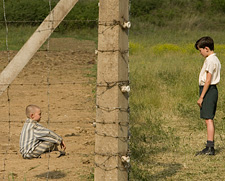It was George Santayana who wrote, "Those who cannot learn from history are doomed to repeat it." But how can someone learn from an event so horrific it seems to defy all imagination? This is the problem faced by holocaust educators and Christian evangelists alike.
 The Boy in Striped Pyjamas is the latest in a long line of productions that aim to educate a new generation unfamiliar with the barbarity of Adolf Hitler's 'final solution' in which some five million Jews were systematically executed. Based on the book by John Boyne, it tells the fictional story of Bruno, the eight year old son of a German officer placed in charge of one of the Third Reich's execution camps. Boredom drives Bruno to investigate the 'farm' that lies behind his new home in the country. Unaware of who these strange people who spend all day in their 'striped pyjamas', he makes friends with a young Jewish boy called Shmuel living on the other side of the camp's electrified fence.
The Boy in Striped Pyjamas is the latest in a long line of productions that aim to educate a new generation unfamiliar with the barbarity of Adolf Hitler's 'final solution' in which some five million Jews were systematically executed. Based on the book by John Boyne, it tells the fictional story of Bruno, the eight year old son of a German officer placed in charge of one of the Third Reich's execution camps. Boredom drives Bruno to investigate the 'farm' that lies behind his new home in the country. Unaware of who these strange people who spend all day in their 'striped pyjamas', he makes friends with a young Jewish boy called Shmuel living on the other side of the camp's electrified fence.
Boyne says that efforts to explain the 'dark heart of the Nazi era' to new generations often come undone because of the scale of the travesty involved. "It seemed that the only respectful way to approach the subject was through innocence," he writes. "I believe that naiveté is as close as someone of my generation can get to the dreadfulness of that period." The filmmakers have seized on that naiveté to find a fresh way of bringing that dreadful knowledge home to today's viewers.
Writer, director and executive producer Mark Herman has produced a harrowing story that is definitely not for the feint hearted. Though the entire tale is told cleverly through the eyes of a child, it softens none of the impact for adult viewers. It is a film of sounds and sights, rather than reasoned arguments, of children playing war games as swastikas reflect in the puddles at their feet. And the black smoke rising from the mass crematoriums is first witnessed from the position of a garden swing. In all, the film achieves its purpose, teaching the viewer how to feel about barbarity of the plot, without the bombardment of distancing statistics.
Bruno's struggle to understand what his happening in the fields behind his house is a struggle that should be familiar to all evangelists. How does one begin to try and explain the total rebellion of humanity to a child? More so, how can modern Christians bring it home to a generation so convinced of the essential goodness of the human heart? If we cannot do so, how well will anyone understand the sacrifice of Jesus, or his or her need to be saved?
Films on the holocaust go some of the distance in reminding us of the depths of human sin, and they would do a magnificent service to humanity if they could prevent such things from happening again. However the truth of the matter is that historical travesties like this continue to occur, not because people do not know, but because they do not want to know. The Christian faces an even harder road, then, because he or she must convince their listeners that not only are Nazis bad, but so is every person who quietly ignores their God-given conscience.
The Boy in Striped Pyjamas is a film about the cusp of understanding, and the responsibility that comes with it. Bruno remains naïve throughout the film, yet even in his innocence he is capable of understanding that a rising conviction of wrong-doing requires the person who feels it to take some step, however small. Would that we might all allow our consciences to question us about the truth of God that lies at the bottom of every heart.



















